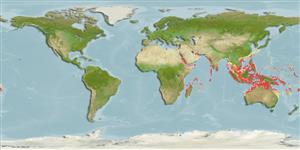Classification / Names
Common names from other countries
Main reference
Size / Weight / Age
Max length : 27.0 cm SL male/unsexed; (Ref. 54980); common length : 20.0 cm SL male/unsexed; (Ref. 188); max. reported age: 8 years (Ref. 1488)
Length at first maturity
Lm 15.0 range ? - ? cm
Environment
Marine; reef-associated; depth range 10 - 75 m (Ref. 12260)
Climate / Range
Tropical, preferred ?; 35°N - 28°S, 31°E - 178°W (Ref. 188)
Distribution
Indo-West Pacific: Red Sea and Mozambique to the Philippines, north to Taiwan and Okinawa (Japan), south to New Guinea, the Arafura Sea (Ref. 9819), northern Australia, and Fiji.
Countries | FAO areas | Ecosystems | Occurrences | Introductions
Short description
Dorsal
spines
(total): 0;
Dorsal
soft rays
(total): 13-21;
Anal
spines: 0;
Anal
soft rays: 12 - 23. Scutes not prominent. Distinguished from A. clupeoides and A. leiogaster by the presence of a series of 10 to 20 gold (in life) or black (on preservation) spots down the flank (but sometimes missing) and more lower gill rakers; from Sardinops species by the absence of a bony radiating striae on its operculum; from Sardinella species by its fewer pelvic fin rays and lower gill rakers.
IUCN Red List Status (Ref. 115185)
Threat to humans
Harmless
Human uses
Fisheries: commercial; bait: usually
More information
ReferencesAquacultureAquaculture profileStrainsGeneticsAllele frequenciesHeritabilityDiseasesProcessingMass conversion
Tools
Special reports
Download XML
Internet sources
Estimates of some properties based on models
Phylogenetic diversity index
PD50 = 0.6250 many relatives (e.g. carps) 0.5 - 2.0 few relatives (e.g. lungfishes)
Trophic Level
2.9 ±0.30 se; Based on food items.
Resilience
High, minimum population doubling time less than 15 months (K=0.37-3.74; tm=1; tmax=8; Fec > 10,000)
Vulnerability
Low vulnerability (17 of 100)
Price category
